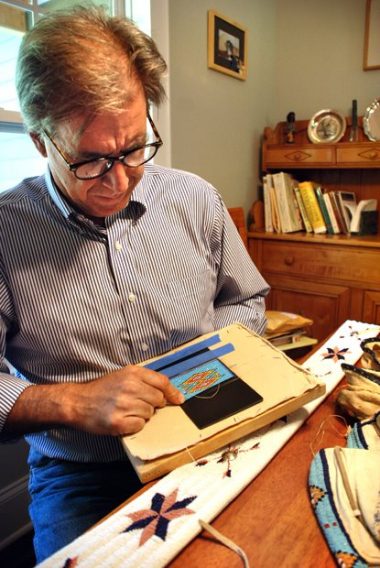Clyde Ellis’ interest in American Indian lore and culture can be traced to his childhood. But it wasn’t until his teenage years that he discovered his love for beadwork art, a passion he cultivates to this day.

“I enjoy this work because of its artistic beauty,” says Ellis, a professor of history. “It’s a medium that very clearly combines traditional material culture with contemporary trends and designs.”
A native of Winston-Salem, N.C., Ellis was first exposed to American Indian culture and crafts through the Boy Scouts. He soon started working with beads based on what he learned on his own, which he says led to many “bone-headed mistakes” concerning materials, designs and colors. As he grew in the trade, Ellis started honing his skills by going to places such as the Smithsonian museum to examine their collections and visiting experienced American Indian beadworkers.
When he moved to Oklahoma in 1986 to begin his doctoral studies, Ellis took every opportunity he had to interact with native craftspeople. He also visited museums and other collections all over the Southern Plains. As he developed a better understanding for the art form and advanced his skills, he specialized in fully beaded Plains-style moccasins and beaded bags.
“Not many people make moccasins; it’s a lot of work,” he says, noting a pair of adult moccasins take anywhere from three to four weeks to make. “There’s a steep learning curve.”
He says beadwork is an adaption from earlier native traditions. While decorating personal artifacts has always been part of tribal traditions, it wasn’t until American Indians came in contact with European explorers and settlers that they started trading and using beads to decorate. By the late 19th and early 20th centuries, techniques and designs reached a high level, combining the best of traditional materials, like brain-tanned hides, old-school designs and an increasingly wide array of colors in very fine beads imported from Italy and Czechoslovakia.

Ellis says much of the beadwork can be read depending on the colors, design and layout. For example, Crow craftspeople use the flat stitch while Cheyenne use lazy or lane stitch. He points at the different tribal traditions represented in some of his own work – a pair of baby moccasins and a card holder in the Crow tradition, a set of fully beaded Kiowa dance clothes, a fully beaded briefcase in the Lakota tradition.
While most of the moccasins and bags he makes are for family and friends, he often trades his work for things he cannot make. For instance, he says, “I cannot do Gourd (round) stitch so I traded a pair of moccasins for a beaded hand fan.”
Ellis says the versatility of the medium allows it to take a variety of forms and designs. Coin purses, ink pens, clothing, saddles and golf club bags are among the items that have been beaded. One of the most interesting moccasin designs he has seen lately features the University of Oklahoma’s “OU” logo in the school’s colors of red and white. It’s not uncommon to see children’s beadwork sets adorned with images of characters such as Mickey Mouse.
“It’s a design medium that lends itself to new ideas,” Ellis says, adding that a lot of the old warrior pictography from the 1900s has been replaced with new icons such as flags and military insignias representative of the 20th century. “Like all good art, it reflects changes in tastes and designs; I appreciate the way it helps us to understand how tradition and innovation go together.”


